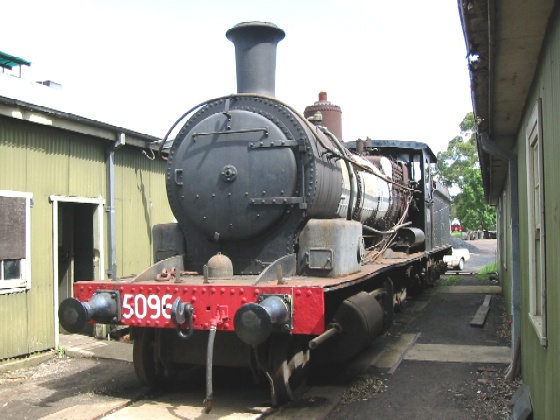|
|
5096 Chullora Heritage Hub |
|

5096 (sans chimney) stored in the Broadmeadow roundhouse on
15 December 2012, with thanks to Jeff Mullier for contributing this photo.
(5096’s chimney was found to be loose during preparation
for rail transfer to Broadmeadow, so it had been removed for safe transport.)
|
Builder |
Granville NSW |
|
Builder’s Number & Year |
1 of 1907 |
|
Wheel Arrangement |
2-8-0 |
|
No. in class |
280 |
|
This
locomotive entered traffic on 6 June 1907 as T 356, one of the highly
successful T(524) class 2-8-0 freight locomotives designed by the New South
Wales Government Railways (NSWGR) in conjunction with Beyer Peacock & Co,
Manchester under the leadership of Chief Mechanical Engineer, William Thow. The
T(524) class grew to number 280 examples following deliveries by several
suppliers, with the design further developed by the NSWGR to the later
TF(939) class (190 examples) and K(1353) class (120 examples) to provide a
total of 590 ‘Standard Goods Locomotives’. The T(524) class were reclassified
as (D)50 class in the 1924 renumbering scheme, with T 356 becoming 5096. (For
more general information about the T(524 / (D)50-class, refer to the page for
preserved loco 5069.) While many
saturated T(524) / (D)50 engines were rebuilt with superheated boilers, 5096
retained its saturated boiler and remained largely unmodified during its
working life. It was withdrawn from NSWGR duties in December 1965 with
2,029,961km of accumulated service and condemned on 17 November 1967 after a
period of use as a static boiler. Fortunately 5096 was saved for preservation
within the collection of the New South Wales Rail Transport Museum (NSWRTM),
not only as the representative of the T(524) / (D)50 class, but also in view
of being the first locomotive constructed by The Clyde Engineering Co Ltd,
Granville. Clyde Engineering went on to construct several hundred steam
locomotives of various types for the NSWGR and other customers, including the
mighty (D)57-class 4-8-2’s and 3801 among the first five (C)38-class Pacific
locomotives. Modern diesel-electric
locomotives also followed. Many
NSWRTM exhibits were worn and rust-streaked on joining the collection in Enfield No.1
roundhouse, having been in open storage following withdrawal. 5096 was among
these and was displayed in 'as received' condition until the early 1980's,
when the boiler clothing and lagging was removed to prevent further decay of
the boiler barrel. (Various components such as the connecting rods, steam
dome cover and sections of boiler clothing remain stored in the tender coal
space.) Some cosmetic rust removal and repainting was done in 1991. Around
2003 the locomotive was assessed for restoration in the workshop area at
Thirlmere by a group of NSWRTM volunteers, but I understand the boiler barrel
was found to be heavily pitted and requiring replacement. 5096 subsequently
remained stored away from public view. During
August 2008, 5096 was rail hauled from Thirlmere for undercover storage at
Broadmeadow Locomotive Depot, Newcastle. (At one stage 5096 had been
allocated for display at the Junee Roundhouse Museum but this did not
proceeded and 5096 remained stored in the roundhouse at Broadmeadow.) 5096 is
significant as the progenitor of many Clyde built locomotives, and also representing
the development of manufacturing in NSW. Hopefully resources can be found for
restoration and public viewing of this locomotive at some stage in the
future. An
excellent resource for detailed information about this locomotive is the fact sheet for 5096 on the NSW Government Office of
Environment & Heritage website. UPDATE: 5096 was relocated
from Broadmeadow to the Chullora Heritage Hub during February 2024 for further undercover
storage and conservation. Hopefully Chullora will provide a suitable restoration
base for 5096 and other worthy exhibits now stored there. |

5096 on the Restoration Road in the workshop area of the NSWRTM, Thirlmere on 17 March 2003.
At the time it was being assessed for possible restoration to operation, but the boiler was found to have severe corrosion pitting.
This area at Thirlmere has since been completely redeveloped as the entrance hall of the new Trainworks museum.
References
|
a |
‘Standards
in Steam – the 50 Class’ by R. G. Preston, Published
by Eveleigh Press, 1992. |
|
b |
‘A
Compendium of New South Wales Steam Locomotives’ compiled by Alex Grunbach, published
by the Australian Railway Historical Society, New South Wales Division, 1989. |
|
c |
‘Steam
Locomotive Data’ July 1974 edition, compiled by J. H. Forsyth for the Public
Transport Commission of NSW. |
|
d |
Wikipedia
entry for the NSWGR D50 class, retrieved
29 July 2015. |
|
e |
Webmaster's
observation or comment. |
Page updated: 27 August 2024
|
Government Railways: |
|
|||||||||
|
Private & Industrial Railways: |
|